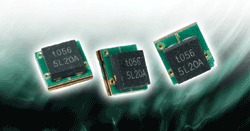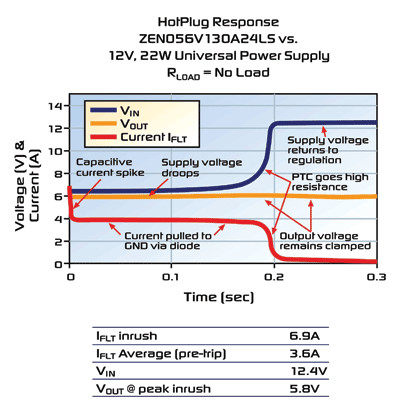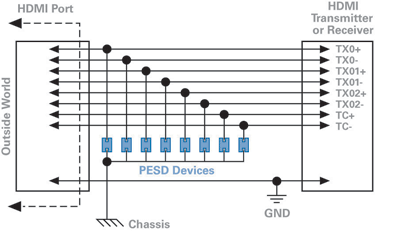Circuit protection options for mobile electronics
Discrete circuit protection devices support emerging infotainment technology to meet new system level needs
BY ADRIAN MIKOLAJCZAK
Tyco Electronics/Raychem CircuitProtection Products
Menlo Park, CA
http://www.circuitprotection.com/
The mobile functionality of portable media players, navigation devices, smart phones, play stations, and other battery-powered portable equipment offers consumers an increasingly connected lifestyle between their home, office, and vehicle. However, this convenience comes with certain risks. Every time these products are connected or disconnected, they may be exposed to circuit damage caused by user error, wrong supply voltages, or voltage or current transients.

Fig. 1. New circuit protection supports the newest mobile equipment.
The evolution of mobile multimedia equipment from audiocentric devices to videocentric storage devices has resulted in higher power requirements, higher data transmission rates, and smaller circuitry. These shrinking mobile designs have also created a demand for smaller, more reliable circuit protection devices. Through accelerated research in materials science and more efficient design, circuit protection device manufacturers are keeping pace by developing new devices that meet existing performance levels within smaller and more convenient packaging (see Fig. 1 ).
This article explores two examples of how new circuit protection technology can help design engineers conserve valuable board space and meet evolving safety and performance standards.
Transient protection design
The number of cell phones now surpasses the number of people in countries like Australia and in many countries, including the U.S., there are more cell phones than landlines. This growth of portable devices not only increases the potential for customer error, but the proliferation of higher power applications leads to increased power demands along with greater risk of inductive spikes and other connection/hot-disconnect transients.
Transient protection is critical when designing peripherals that may be powered from computer buses and automotive power buses. On computer buses, inductively generated voltage spikes can exceed 8 V on the 5-V line and 16 V on the 12-V line, which can damage unprotected peripherals. With the advent of low-cost third-party ac-to-USB converters, and car cigarette lighter-to-USB converters, the potential for transients to be seen on computer buses continues to increase.
Automotive power buses are notoriously dirty. Although they are nominally 12 V, they can range in normal operation from 8 to 16 V. Still, battery currents can exceed 100 A and can be stopped instantly via a relay or fuse, generating large inductive spikes on the bus and increasing voltage fivefold or more. The potential for inductive spikes increases with the growth of high-power electronics content in vehicles.
Third-party power converters are increasingly common, however, and may filter some transients, but testing by Tyco Electronics shows that their transient suppression capabilities vary widely. Custom-keyed power connectors are sometimes employed to prevent the use of incorrectly rated or improperly designed power supplies. This solution incurs custom-tooling costs, though, and is not necessarily insulated from the creation of third-party adapters.
In another protection scheme, high-voltage capable silicon solutions can be designed to provide a regulated voltage output and overvoltage lockout. The problem with the integrated silicon approach is that there is usually a significant price premium associated with this method.
Traditional clamping diodes represent the simplest protection solution. However, to withstand the potential power output of a nonapproved charger while still providing resettable protection, this diode must be capable of dissipating nearly all of the power that a non-approved charger could deliver. The resultant protection solution would therefore require both a large diode and significant heat-sinking infrastructure, making it an impractical choice.
Polymer-enhanced zener
An alternative solution is the polymer-protected zener diode, which offers designers the simplicity of a traditional clamping diode while obviating the need for significant heat sinking. This device not only helps protect sensitive electronics from damage caused by the use of improper power supplies, it also helps provide transient suppression, reverse bias protection, and overcurrent protection in a small, single package.
As shown in Fig. 2 , the polymer-protected zener diode micro-assembly incorporates a stable zener diode for crisp voltage clamping and a resistively non-linear PPTC (polymeric positive temperature coefficient) layer. The PPTC layer responds to either diode heating or overcurrent events by transitioning from a low to high resistance state. In the event of a sustained high-power overvoltage condition, the tripped PTC element limits current and generates voltage drop to help protect both the zener and the follow-on electronics – effectively increasing the diode’s power-handling capability.

Fig. 2. PolyZen device provides input power protection for portable electronics.
This device is particularly effective at clamping and smoothing inductive voltage spikes. In response to an inductive spike, the zener diode element shunts current to ground until the voltage is reduced to the normal operating range. In the case of a wrong-voltage power supply, the device clamps the voltage, shunts excess power to ground, and eventually locks out the wrong supply, as shown in Fig. 3 .
The relatively flat voltage vs. current response of the polymer-enhanced zener diode helps clamp the output voltage, even when input voltage and source currents vary. Simply put, the polymer-enhanced device provides a component that protects like a zener diode, but can withstand very high power fault conditions without requiring any special heat sinking structures beyond normal PCB traces.

Fig. 3. Polymer-enhanced zener diode clamps and smooths inductive voltage spikes.
PESD devices
Very-high-speed differential interfaces are now found in virtually every consumer electronics device. From USB 2.0 to E-SATA to the proprietary HDMI 1.3, differential signaling has become the preferred method of transmitting and receiving data. A major design challenge in these high-speed applications is to ensure that an electronic device’s ESD protection needs are met.
In these applications, the parasitic impedance of traditional protection devices can distort and deteriorate signal integrity, making low capacitance ESD protection critical to maintaining data integrity.
Low insertion loss and stable capacitance, across a broad frequency range, also make a significant contribution to the design goals of adequate protection, low cost, and minimal signal attenuation. Insertion loss is an important measure of signal attenuation vs. frequency. Higher insertion loss translates to lower bandwidth in the device and system.
An ESD protection device’s capacitance vs. frequency behavior can also affect the high-speed port’s design performance, as well as impose design constraints. In high-speed systems, circuits designed for a certain capacitance can behave differently depending on the ESD protection technology used.
Figure 4 shows a typical HDMI circuit protection design using Tyco Electronics’ PESD devices. These protection devices help shunt ESD away from sensitive circuitry and provide exceptionally low capacitance compared to traditional MLV (multilayer varistor) or TVS (transient voltage suppression) diode technology.

Fig. 4. Typical HDMI circuit schematic with PESD devices.
PESD devices perform better than other comparable components in transmission line pulse (TLP) testing, as well as IEC61000-4-2 testing, especially after multiple hits (up to 1,000). The device’s low trigger voltage and low clamping voltage also helps protect sensitive electronic components. ■
For more on circuit protection devices, visit http://www2.electronicproducts.com/Passive.aspx.
Advertisement
Learn more about TE Connectivity





